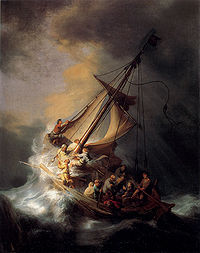
Calming the storm
Encyclopedia

According to the Gospels, one evening Jesus and his disciples were crossing the Sea of Gallilee in a boat when a furious storm came up, with the waves breaking over the boat, so that it was nearly swamped. Jesus was in the stern, sleeping on a cushion, but the disciples woke him and said to him, "Teacher, don't you care if we drown?" The Gospel of Mark then states that:
He got up, rebuked the wind and said to the waves, "Quiet! Be still!" Then the wind died down and it was completely calm. He said to his disciples, "Why are you so afraid? Do you still have no faith?" They were terrified and asked each other, "Who is this? Even the wind and the waves obey him!"
Author Michael Keene commented that the Sea of Galilee was known for its sudden and fierce storms and that the Jews were people of the land who were generally uncomfortable at sea, specially since they believed the sea to be full of frightening creatures.
Author John Clowes commented that by asking the question "Why are you so afraid?" Jesus was asking his disciples to explore in their own minds the cause and origin of fear, so they would realize that all fear has its roots in natural affection and thought, separate from spiritual affection and thought. And by asking "Do you still have no faith?" Jesus was manifestly pointing to a defect in their spiritual principles.
Clowes further commented that by that last question Jesus was manifestly instructing his disciples, and through them all future generations of mankind, that fear is the constant result of the weakness of Heavenly principles in the human mind.
See also
- Chronology of JesusChronology of JesusThe chronology of Jesus aims to establish a historical order for some of the events of the life of Jesus in the four canonical gospels. The Christian gospels were primarily written as theological documents rather than historical chronicles and their authors showed little interest in an absolute...
- Ministry of JesusMinistry of JesusIn the Christian gospels, the Ministry of Jesus begins with his Baptism in the countryside of Judea, near the River Jordan and ends in Jerusalem, following the Last Supper with his disciples. The Gospel of Luke states that Jesus was "about 30 years of age" at the start of his ministry...
- Miracles of JesusMiracles of JesusThe miracles of Jesus are the supernatural deeds of Jesus, as recorded in Gospels, in the course of his ministry. According to the Gospel of John, only some of these were recorded. states that "Jesus did many other things as well...
- Parables of JesusParables of JesusThe parables of Jesus can be found in all the Canonical gospels as well as in some of the non-canonical gospels but are located mainly within the three synoptic gospels. They represent a key part of the teachings of Jesus, forming approximately one third of his recorded teachings...
- Jesus walks on water

